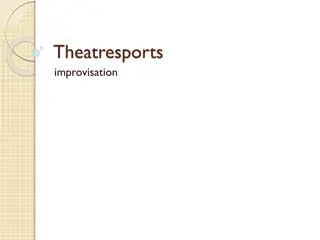
Efficient Hospital Theatre Design Guidelines
Learn about the design guidelines for a hospital theatre, including the importance of separate units, self-closing doors, and hygienic materials. The theatre should be centrally located near critical care units and have specialized areas like renal and burns units. The infrastructure should prioritize cleanliness, ventilation, and safety measures to create an optimal surgical environment.
Download Presentation

Please find below an Image/Link to download the presentation.
The content on the website is provided AS IS for your information and personal use only. It may not be sold, licensed, or shared on other websites without obtaining consent from the author. If you encounter any issues during the download, it is possible that the publisher has removed the file from their server.
You are allowed to download the files provided on this website for personal or commercial use, subject to the condition that they are used lawfully. All files are the property of their respective owners.
The content on the website is provided AS IS for your information and personal use only. It may not be sold, licensed, or shared on other websites without obtaining consent from the author.
E N D
Presentation Transcript
Is a block of building with a series of rooms leading off a corridor. With self separate it from the main hospital. The doors reduce unnecessary movement to and from theatre. self- -closing doors, closing doors, which
A theatre should be built in a a central place intensive care unit, accident/emergency department The surgical wards and other special wards, for example, renal unit and burns unit. central place possibly near an intensive care unit, accident/emergency department renal unit and burns unit.
All these units should be in relation to each other, but construction should be separate and independent from all traffic and air movement within the hospital. A theatre unit is self contained with changing rooms, shower rooms, toilets, operating room, recovery room; at least four beds, sluice room, linen room and sterilizing room. changing rooms, shower rooms, toilets, anaesthetic operating room, recovery room; at least four beds, sluice room, linen room and sterilizing room. anaesthetic room, room,
Inside, the walls, floor and roof are built with labour saving materials for hygiene purposes. It has artificial ventilators, efficient artificial lights and emergency systems for use during power failure.
The theatre furnishings and fittings are made of stainless materials for quick and thorough cleaning. All the trolleys are fitted with non rubbers electric conduction. non- -electricity conducting rubbers to minimize the risk of electricity conducting
Washable paint, smooth walls, and round corners. Ceiling may be used for mounting operation light and other electrosurgical units. Walls must be fitted with outlet of oxygen and other medical gases, vacuum and electric outlets. Floor: without cracks, curved at the wall for easy cleaning, nonslip surface for to prevent injury to staff. of oxygen and other medical gases, vacuum and electric outlets. Floor: Terrazzo material, smooth
Windows frequent opening and closing. Lighting : minimum shadow, should be evenly distributed in the room. Overhead operating light daylight without shadow and minimum heat Ventilation : ensures clean and filtered air supply Positive air pressure flows; the room. Temperature and humidity; to 25 degrees Celsius. Windows: clear glass view windows to prevent Lighting : white fluorescent they cast Overhead operating light, provides near Ventilation : mechanical ventilation which Positive air pressure flows; forces air out of Temperature and humidity; maintained at 20
Unrestricted area An area of the building that is not defined as semi-restricted or restricted. This area includes a central control point for designated personnel to monitor the entrance of patients, personnel, and materials into the semi-restricted areas. Unrestricted area
This area may include staff rooms, offices, waiting rooms, the preoperative admission area,and PACU Public access to the area may be limited based on the facility's policy and procedures.
Semi The peripheral support areas of the surgical suite. The area may include storage areas for equipment and clean and sterile supplies; work areas for processing instruments; sterilization processing room(s); scrub sink areas; corridors leading from the unrestricted area to the restricted areas of the surgical suite; Semi- -restricted area: restricted area:
and the entrances to locker rooms, preoperative admission area, the PACU, and sterile processing. This area is entered directly from the unrestricted area past a nurse s station or from other areas. Personnel in the semi-restricted area should wear surgical attire and cover all head and facial hair. Access to the semi-restricted area should be limited to authorized personnel and patients accompanied by authorized personnel. a nurse s station or from other areas. should wear surgical attire and cover all head and facial hair.
Restricted area: space contained within the semi- restricted area and accessible only through a semi-restricted area. The restricted area includes the operating and other rooms in which surgical or other invasive procedures are performed. Personnel in the restricted areas should wear surgical attire and cover head and facial Restricted area: A designated the operating and other rooms in which surgical or other invasive procedures are performed. wear surgical attire and cover head and facial hair. hair.
Masks should be worn when the wearer is in the presence of open sterile supplies or persons who are completing or have completed a surgical hand scrub. Only authorized personnel and patients accompanied by authorized personnel should be admitted to this area. worn when the wearer is in the presence of open sterile supplies or persons who are completing or have completed a surgical hand scrub. Only authorized personnel and patients accompanied by authorized personnel should be admitted to this area.
Personal protective equipment (PPE) Specialized equipment or clothing for eyes, face, head, body, and clothing; respiratory devices; and protective shields and barriers designed to protect the worker from injury or exposure to a patient s blood, tissue, or body fluids. Personal protective equipment (PPE) or clothing for eyes, face, head, body, and extremities; protective clothing; respiratory devices; and protective shields and barriers extremities; protective
Used by health care workers and others whenever necessary to protect themselves from the hazards of processes or environments, chemical hazards, or mechanical irritants encountered in a manner capable of causing injury or impairment in the function of any part of the body, through absorption, inhalation, or physical contact.






















